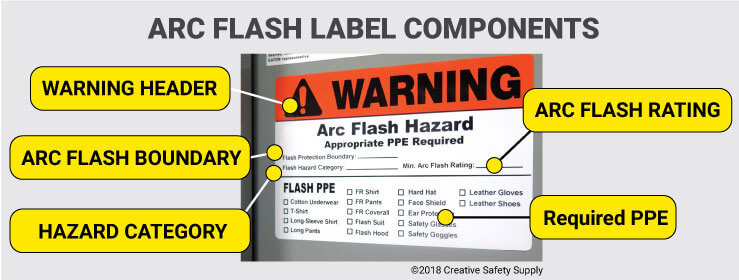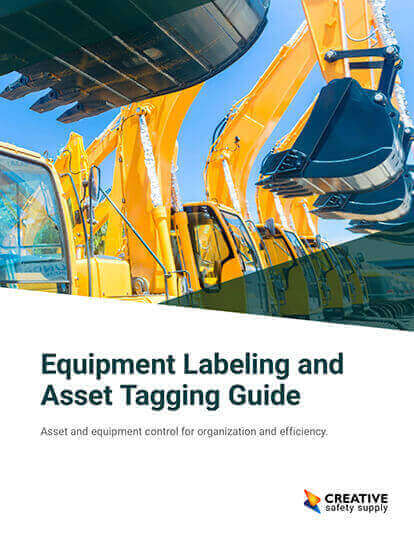
Arc flashes are one of the most dangerous potential incidents that can happen in a facility. There is a risk of an arc flash occurring in any environment where high voltage cables or equipment are present, though a variety of factors can raise or lower the overall risks.
Arc flash labeling has been used for many years to help warn people of the risks, and encourage them to wear the proper personal protection equipment to mitigate the dangers. In 2004, the NEC 110.116 pointed to the NFPA 70E-2004 guidelines for recommendations on how to handle labeling, but even at this time there were no enforceable requirements.
Even when there are no legal requirements for arc flash labeling, most facilities will use these labels to help keep their employees, and the surrounding equipment, as safe as possible. Understanding all the current arc flash label requirements, and how they can help keep a facility safe, is an important task for any safety manager.
Arc Flash Label Requirements
One of the most important arc flash label requirements is that a company needs to field-label all their electrical equipment that has the risk of a dangerous arc flash. This is according to the NFPA 70E requirements. There are some disagreements and disputes regarding exactly what this requirement entails.
Some facilities mistakenly believe that they can just use generic electrical hazard labels, but that is not the case. When there is the risk of an arc flash occurring, it is necessary to have specific labeling in place that provides this warning. Offering the proper personal protection equipment is also a requirement for these types of environments.

Arc Flash Safety
These labels are critical for arc flash safety because they not only warn of the risk of an arc flash, but also provide the necessary information for choosing what type of personal protection equipment is needed. The higher the voltage present, the more requirements there will be for PPE. The required PPE can include gloves, full body suits, and more.
Having these types of labels clearly displayed on the machines, cabling, or other equipment will help ensure everyone is aware of the risks, and how to remain protected from them. Even using the right tools, which are made from materials that won't conduct electricity, can help to reduce the risk and improve arc flash safety in a facility.
Arc Flash Warning
Warning people of an arc flash can be more difficult than one might think. Simply putting up warning labels can be effective at first, but over time, employees will become "blind" to them. This is why it is best to have a more comprehensive arc flash warning system in place.
In addition to just the arc flash labeling, many companies use arc flash posters, arc flash floor signs, and even provide training that is focused specifically in this area. The more different approaches a company uses on this subject, the more likely it will be that employees recognize the threat, and respond properly to stay safe.
NFPA 70E 2018 Revision
Per usual, NFPA periodically reviews their standards and codes in an effort to stay up to date with industry trends and research. Although not enforceable by law, it’s important to review the new changes and begin incorporating them in your facility.
The 2018 revision of NFPA 70E brought some changes to arc flash labeling requirements. Arc flash warning labels must include either the calculated incident energy or the level of PPE required. This update is meant to make it easier for qualified workers to select the proper PPE for the job. Additionally, NFPA 70 E 130.5(H) Exception No. 2 now also permits eliminating detailed information from the arc flash label in specific circumstances. Review the details of the 2018 70E standard to ensure your workplace is free from electrical hazards.
It should be noted, any labels affixed on equipment prior to the update are still in compliance with safety requirements.
Arc Flash Label Options
Finding the right balance between low cost, and high effectiveness, for arc flash labeling can be difficult. In many cases, companies are reluctant to pay the higher price for the number of custom made labels that they will need. When this is the case, having an on-site industrial label printer can be an effective option. This will reduce the overall cost per label significantly, while still ensuring that the labels can be customized as needed.
It is also possible to use some pre-printed generic labels in some areas, combined with the custom printed options in others. Facilities need to keep in mind that their primary goal when it comes to arc flash labeling is to ensure the safety of their employees, and anyone else who happens to be working in the area.
Arc Flash Stickers
Most of the arc flash labeling options will come in the form of arc flash stickers. These stickers can be custom ordered, or printed on site. Safety managers simply identify the areas in the facility where there is a risk, and put the stickers directly on the walls, machines, cabling, or other items present. Making sure that the labels are easily visible is also very important.
Arc Flash Signs
Another option is to use arc flash signs. These signs are typically going to be larger than a standard label, which will make them more visible. The larger signs will also have more room for information about the risks, which can be helpful in many situations.
Arc Flash Posters
Arc flash posters are another excellent way to quickly convey information. Posters are larger than signs or labels, and can be beneficial to put up in almost any environment. Many facilities have posters about arc flash safety hung in the break room or other common areas so that employees can read about this risk at their convenience. Rather than strictly trying to be a warning, arc flash posters are more informational in nature.
Planning and Implementing Arc Flash Labeling Standards
As long as a company is meeting the minimum requirements for safety, the specific ways that arc flash labeling is conducted is left up to the safety manager of the facility. Having a set of standards that is followed throughout the facility (or even multiple facilities) is the best way to ensure employee and facility safety.
Following the same standards at all times will help to make sure that everyone knows how to react to the potential hazards in an area. Since arc flash hazards are present in many different environments, the standards need to make it very clear that there is a risk of an arc flash, what can be done to reduce this risk, and how to protect oneself should the arc flash occur.
Resources
- https://www.ecmweb.com/maintenance-repair-operations/article/20899008/the-seven-deadly-misconceptions-of-arc-flash-labeling
- https://ohsonline.com/articles/2010/09/14/arc-flash-label-best-practices.aspx
Similar Articles
- Arc Flash Label Requirements [2018 Updates]
- Arc Flash PPE
- Arc Flash Software helps improve Arc Flash Safety
- Arc Flash [Facts, Safety Requirements & PPE]
- Arc Flash and Electrical Safety
- Solar System Labeling
- Labeling Electrical Conduits
- Hazardous Materials Identification System (HMIS Labels)
- Anhydrous Ammonia – Safety & Labeling


